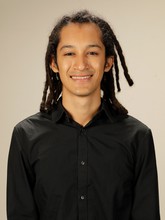Les milieux fluides ne s'opposent pas aux forces de cisaillement. En d'autres termes, la dynamique des fluides est l'étude du mouvement là où tous les mouvements sont permis.
∂u/∂t + (u∙∇)u = (-1)/ρ ∇P + ν∇² u + f
L'équation de Navier-Stokes ci-dessus est une des relations fondamentales indiquant que le mouvement fluide (représenté par le champ de vitesses u ) résulte de l'équilibre entre trois actions :
(-1)/ρ ∇P est le gradient de pression, la différence perçue par le corps entre sa situation présente et le champ des possibles. ∇P est le langage fluide : les ondes de pression se propagent de proche en proche. Une compression augure la venue d'un obstacle et une détente indique que la crise est passée.
+ ν∇² u est la viscosité du corps, sa résistance au changement. Les corps visqueux bougent avec effort puisque toutes ses composantes veulent garder leur cohésion. Les fluides non visqueux sont sur-excités par toute énergie, leur changement est volatile et incontrôlé.
+ f est une force extérieure, comme la gravité, qui agit identiquement sur tous les corps, mais avec des résultats différents selon la nature de chacun.
Comme tout autre corps fluide, moi aussi je suis soumis à des forces de cisaillement. Moi aussi je suis attiré vers les situations de moindre pression. Un gradient adverse peut me décélérer, me détacher de mon chemin déclenchant des instabilités et turbulences. Je réagis différemment aux forces extérieures qui s'appliquent aussi sur mes pairs. Il suffit de peu pour qu'on soit guidés dans des chemins opposés. Ma viscosité maintient ma cohésion interne, mais empêche les changements nécessaires.
De l’ONERA- Bruno Mialon, Eric Deletombe, Vincent Brion, Marie Couliou, Geoffrey Tanguy, Thomas Huret, Jeanne Descamps, Elvina Derhille, Baptiste Isnard, Nicholas Vauchel, Alexandre Gounand, Lauriane Lefevre et Jacques Pruvost.
Du FRESNOY- Kris Verdonk, Eric Prigent, Elodie Wattiaux, Cyprien Quairiat, Guillaume Delsert, Julie Ramage, Victor Villafagne et Alexandre Peschman.
De l’EXT- Diana Hentulescu, Remi Lamour. Ma famille- Franco Chavarria, Mauri Cruz, Nadia Marquez et Javier Cruz
Le Fresnoy - Studio national, L’ONERA, Le LMFL, La Région Hauts-de-France, École Doctorale ENGSYS Lille, Centrale Lille Institute.

Costaricain, lauréat d’une bourse Excellence-Major de l’AEFE, Rolando Cruz Marquez est doctorant en aérodynamique au centre ONERA de Lille. Ses recherches portent sur la dynamique et le contrôle des vortex de sillage créés par les aéronefs. Dans son travail d’artiste, la mécanique des fluides lui permet d’étudier l’interaction entre notre sensibilité et le monde extérieur.
Etienne Landon : conception mécanique
Hazem Berrabah : Etalonnage
Hélène Motteau : Directrice de photographie (ce rôle était antérieurement attribué à Guillaume Delsert)
Hamza Mrabet : Montage
Nino Vincent_Electro/Eclairagiste






